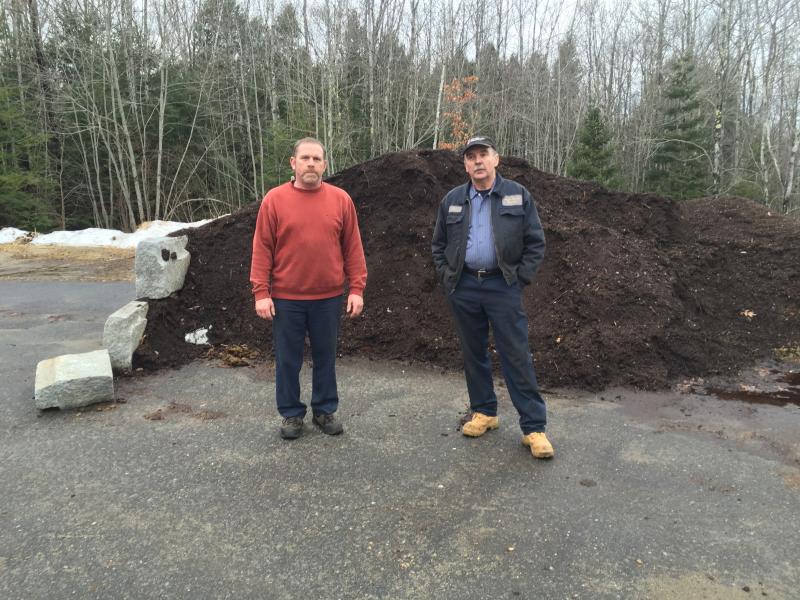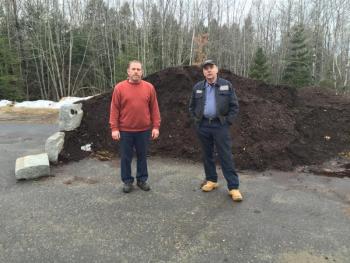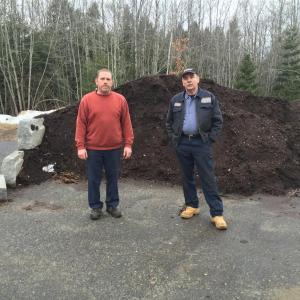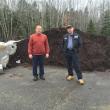Sustainable waste
 Composters Tim Richardson and Bob Gryspeerd stand before a finished pile of compost at the recycling center. GINA HAMILTON/Wiscasset Newspaper
Composters Tim Richardson and Bob Gryspeerd stand before a finished pile of compost at the recycling center. GINA HAMILTON/Wiscasset Newspaper
 Composters Tim Richardson and Bob Gryspeerd stand before a finished pile of compost at the recycling center. GINA HAMILTON/Wiscasset Newspaper
Composters Tim Richardson and Bob Gryspeerd stand before a finished pile of compost at the recycling center. GINA HAMILTON/Wiscasset Newspaper
Lincoln County has been ahead of the curve in sustainability for many years. It began recycling before almost anyone else had even heard of the word, in 1978, and is still the only county in New England that organizes recycling at a county level, County Administrator John O’Connell said in a paper he delivered to the University of Southern Maine last year.
The county is now moving, slowly and tentatively, into recycling of organic waste. While some municipalities, such as Bath and Brunswick, are helping citizens with things like inexpensive home composters, Lincoln County is actively creating compost at its recycling facility in Wiscasset, near Huntoon Grange.
Part of the reason is economic. According to records issued to the county commissioners, tipping fees at the landfill in Orrington, where Lincoln County sends its solid waste, are currently $76 per ton, and are slated to rise this year. Juniper Ridge Landfill will be full in 2020.
A lot of household waste is used for compost, according to a power point demonstration called “Lincoln County Composts.” Food scraps make up about a quarter of household trash, and leaf and lawn waste is another 13-14 percent. If every household set aside organics for composting, the amount of waste that would go into the landfills would drop drastically, saving the county a great deal of money.
But there is another reason for composting, and that is the issue of sustainable waste disposal. Composting creates healthy new soil, not trash in a landfill. With the landfill slated to close within just a few years, Lincoln County needs to decrease the amount of waste it generates, and recycle even more than it does now.
Many households are interested in community composting, but bringing everyone online is a slow process. Collection is a problem, O’Connell said. To establish a county-wide program for home pickup, like the Garbage to Gardens program in the greater Portland area, would mean more trucks, more drivers, more people to work the compost, and more sites to bring the scraps to. Even providing compost “totes” at various transfer stations for people to bring their own waste in is not something every site wants to do, although it is working well where it has been established, in Damariscotta, Nobleboro and Wiscasset.
The Huntoon Hill site is operating near capacity. Additional grants would be needed to expand that site, or to open other sites in other areas. A possible connection could be made with Two Bridges Regional Jail, which could compost its own waste and accept the waste from other locations, but there are limits to how much they can do, because the jail cannot pay inmates for work until after they are sentenced, which would leave out a lot of potential inmate laborers. High schools could take part, as well as other transfer stations in the county, but space has to be dedicated for the compost and people have to be identified who want to work with it.
O'Connell said recycling and composting are going to be essential as the cost rises and the places to put the waste decrease. “Rockland is thinking of opening up another quarry for a landfill,” he said. “We have to work harder to decrease what we're putting into landfills, not open up more of them.”
The composting project is still a pilot project, but while there is little room to maneuver at the Huntoon Hill location, there is hope that beyond the pilot, other locations will come on board elsewhere in the county. Tim Richardson and Bob Gryspeerd collect food scraps from several other towns, including Damariscotta and Nobleboro, that have set up collection bins at their transfer stations, as well as from Wiscasset Elementary School. A collector, Ethan Majer, brings food scraps from residents and a few restaurants. The communities also contribute lawn and leaf waste, some breweries bring used hops, and some fishermen bring seaweed and lobster bodies. Local farmers contribute horse manure.
The horse manure is key.
“You need the manure to burn the food scraps,” Richardson said. “The whole pile heats up and causes the material to decompose.”
While compost would occur eventually without the manure, manure contains nitrogen in large amounts, a key element of any fertilizer. But manure cannot be placed directly on the soil until it is well-rotted, because it is strong enough to burn the roots of crops. In a compost pile, manure serves as the spark to heat up the pile and begin decomposition, even in cold weather. Some manures are more potent than others. As manure goes, horse manure is fairly dry and contains less nitrogen than, say, chicken manure, which makes it easier to work with at a large-scale composting facility. It's also friendlier to the water, because any large pile of manure, unless kept in an enclosed bin like a small home composter, is exposed to the elements, and runs off into the water table.
The men mix the food scraps, the leaf waste, and the manure into large piles. Both “brown” waste — dead leaves, hay, wood ash, eggshells and paper, and “green” waste — fruit and vegetable parings, lawn clippings and garden waste, leftover milk, heads of lettuce that have gone bad, that sort of thing — are needed to make a compost that will help to grow flowers and vegetables. Each type adds important nutrients to the new soil. Green waste adds nitrogen and acid to the soil; this is balanced by brown waste, which adds more carbon, making the resulting soil more alkaline. Since many vegetables and flowers prefer slightly acidic soil, it’s important to balance the waste products correctly.
Depending on the weather, it can take several months for the decomposition to be complete. Decomposition slows down in the winter, and can be very rapid in the summer. The piles are turned, using a modified tractor, and reformed into piles to have any non-decomposed elements strained out. Then it is ready for sale. The price the recycling center offers is $25 per yard, or $5 per 35-pound bag. Every year, the center produces between 100 and 150 yards of compost.
Getting enough horse manure is something of a problem, since a horse farm nearby sold their animals last year, Richardson said. “We can only accept horse manure from Lincoln County as part of this grant,” he said. “But we're always looking for more.”
The 28 composting participants in the pilot project have been enthusiastic and prolific. In 2013, the participants produced 1,983 pounds of food scraps. In 2014, they produced 3,134 pounds.
The goal is to make the program self-sustainable, by the sale of its compost. “It works as long as we don't have to put a lot of money in,” Richardson said. “Last year, we had to repair the tractor, and that was a $1,500 expense. But barring those kinds of expenses, we should break even every year.”
The $25,000 grant that Lincoln County received for the pilot project three years ago went to make sure there was a long, level “pad” to hold the composting material. Anything beyond that, including the pay of the five people involved, is expected to come from the expected savings from the waste tipping fees and the sale of the compost.
“We're optimistic that this will be a long-term solution to the organic waste stream problem,” O'Connell said. “But it will take time to bring everyone on board.”
Event Date
Address
Huntoon Hill Road
Wiscasset, ME
United States






















